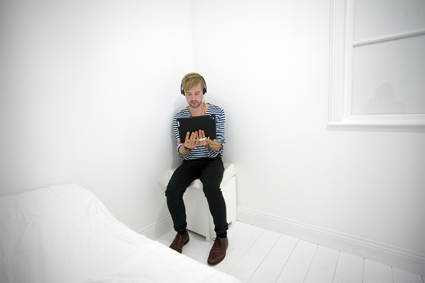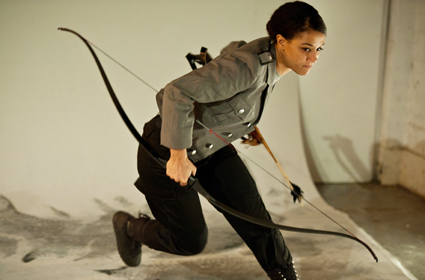liberation and/or annihilation
john bailey: fish & game; hayloft project; malthouse

Alma Mater
photo Ponch Hawkes
Alma Mater
THERE’S A LABORATORY IN THE US THAT APPARENTLY HOLDS THE RECORD FOR THE WORLD’S QUIETEST PLACE—SO ACOUSTICALLY INSULATED THAT ANYONE INSIDE THE ROOM WILL HEAR NOTHING BUT THE SOUNDS OF THEIR OWN BODY.
To hear your very blood circulating, your organs heaving, is supposed to be an alarming experience and few can last long in the anechoic chamber without risking their sanity. I don’t know if that’s true, but the story has some psychic pull to it, given the way it dramatises something nigh impossible in our lives today: the idea of being completely alone.
Theatre, for the most part, doesn’t play with aloneness all that much. It’s a social art, and if a work addresses solitude at the level of narrative, you’re usually witnessing it in a roomful of fellows. Even if you’re the only person who’s fronted up on the night, or it’s a play-for-one, you’re likely in a space with another human being performing in some manner. Theatre is shared.
alma mater
That’s why UK duo Fish & Game’s Alma Mater proves such a striking encounter—striking in the sense of a blow, a box about the ears. It’s deceptively simple to describe. The lone audience member is given an iPad and headphones and sent into a small, artificially constructed room where they close the door behind them. The interior and its minimal furnishings—a bed, chair, dresser–is entirely white, a blank. The short film that plays out on the tablet’s screen, it becomes apparent, takes the same point of view as the person watching it, scanning the room as you pan in each direction. And then the ghosts appear. The device becomes a puncture in space, two pale children suddenly emerging and acknowledging the presence of the viewer.
While it doesn’t sound like much, the construction of the environment is integral to the phantasmic experience. It’s as if the mind struggles with the idea of being so completely alone, and gives the images on the screen more weight in reality as a result. Of course the kids aren’t in the room with you, but there’s an uncanny sense that they might be, in some way, or have left some real traces that hover behind you.
The drama that unfolds expands upon this prickling haunting: the room onscreen gradually becomes more embellished, the children discovering a bird in a cage, colour on walls, a family. A mystery begins to develop, involving a possible death, a transformation, a sinister sister with a murderous baking habit. We’re now in a space where something terrible may have occurred, and the children still regularly turn to look at us, their inscrutable expressions raising too many questions: are they asking us to help? Or to merely bear witness? Or is there something accusatory in there? Who, in the end, are we?
The whole encounter lasts barely 20 minutes but it’s riddled with enigmatic meanings that linger well after you exit the room. I left wanting to call someone, to talk to some real person if only to rid myself of the eerie sense that being so very alone opens up the possibility of visitations from places I’m pretty sure don’t exist. Which, some might argue, is one effective definition of art.
the seizure

Naomi Rukavina, The Seizure
photo Lachlan Woods
Naomi Rukavina, The Seizure
The Hayloft Project’s latest work explores the hellishness of solitude in another form. The Seizure takes up the story of Sophocles’ Philoctetes, a soldier abandoned on a miserable island after an injury to his ankle. Here he has spent a decade in isolation, eating birds, picking at the festering wound that never heals. His only interlocutor is a crow, and in keeping with writer Benedict Hardie’s modern and secular interpretation, this chorus may well be a projection of Philoctetes’ own mental state. The divine is a pointed absence in this adaptation—there will be no salvation from Beyond.
When other humans do arrive—Neoptolemus and Odysseus, hoping to convince their fallen comrade to return to the war effort—we see how Philoctetes’ plight has become his being. He refuses to rejoin society, having seen how the fight itself is an undying machine that feeds on the bodies of men. If his wound is the thing that removed him from the cycle of death, then perhaps that is why he cannot allow it to be mended—this is the puncture that allows him a glimpse of the reality of war.
It’s a sparse and solemn production. In the past Hardie has proven a wonderful ability to show how words may both convey and obscure meaning (the outstanding Yuri Wells, for instance; RT94, p8) but here he holds back the linguistic fireworks in favour of a subtle, reverential poetry that serves its source well. The design is also unobtrusive: an almost featureless white space, with only a slash of black ink cutting a scar across the otherwise blank vista. Despite all of this, there’s much contemporary resonance to the piece, suggesting as it does that freedom is a sentence, not a gift.
the histrionic
Thomas Bernhard’s The Histrionic presents another vision of a self-imposed solipsist. The titular pomp, Bruscon, is a theatre-maker who has fashioned the entirety of human existence as his own reflection. He tours the country with his epic The Wheel of History, in which he dramatises the lives of great men by playing them himself. We find him in a pitiful backwater where he is attempting to stage a production of the play, facing down local safety regulations, substandard staging conditions and the resentful members of his family he requires to play supporting roles. He brings to all of this the kind of outrageous arrogance that at first seems to situate Bernhard’s work in farcical territory, but quickly expands to become something much more.
Bruscon is a fascinating tyrant who rails against the residual fascism he sees infecting post-war Europe while acting as its most potent expression. His art transforms human experience into a grotesque parody of itself, serving only to bulwark his ego at the expense of those around him. It results in literal violence against his family, just as it enacts its own form of symbolic violence. On a surface level this maker of a world is Hitler, but he is also the essence of the artist for whom the work stands above its subjects.
Bernhard’s brilliant creation here is also a condemnation of himself, the writer, and there are pointed connections between his monster and his own professional history. This is absolutely necessary, for to remove himself from the frame would be to commit the very same crimes of which he accuses Bruscon. To write himself in, of course, is to admit that those crimes are ones he’s guilty of already. It’s a slippery move but it adds immeasurably to the compelling complexity undergirding the entire work.
Where Philoctetes’ plight makes loneliness a tragic demand of freedom, and Alma Mater suggests that isolation breeds demons, Bruscon is the artist who seeks to remove himself from the degradation of civilisation by reducing the world to something he may command. While there’s plenty of laughter involved, especially given Bille Brown’s masterful performance, this theatre-maker may offer up the most chilling implication of creative solitude: to truly stand alone, free of influence and interpretation, is liberation as an act of annihilation.
Alma Mater, created by Fish & Game, directors Robert Walton, Eilidh MacAskill, cinematography Anna Chaney, music John De Simone, performers Lucy Gaizely, Albie Gaizely-Gardiner, Lyla Gaizely-Gardiner, Raedie Gaizely Gardiner, Gary Gardiner, Becki Gerrard, Thom Scullion, Mr Feathers, Ensemble Thing, design Phil Bowen, Hugh Speirs, Arts House, North Melbourne Town Hall, Apr 18-May 13; The Hayloft Project, The Seizure after Sophocles’ Philoctetes, writer, director Benedict Hardie, performers Christopher Brown, Haiha Le, Brian Lipson, Naomi Rukavina, dramaturgy Anne-Louise Sarks, design, costumes Zoe Rouse, lighting Lucy Birkinshaw, sound design Alister Mew, Studio 246A Brunswick, May 3-19; Malthouse Theatre & Sydney Theatre Company, The Histrionic, writer Thomas Bernhard, translator Tom Wright, director Daniel Schlusser, performers Bille Brown, Kelly Butler, Barry Otto, Josh Price, Katherine Tonkin, Jennifer Vuletic, Edwina Wren, set, costumes Marg Horwell, lighting Paul Jackson, sound design, composition Darrin Verhagen, CUB Malthouse, Apr 2-May 5; STC, Jun 20-Jul 28
RealTime issue #109 June-July 2012 pg. 24






